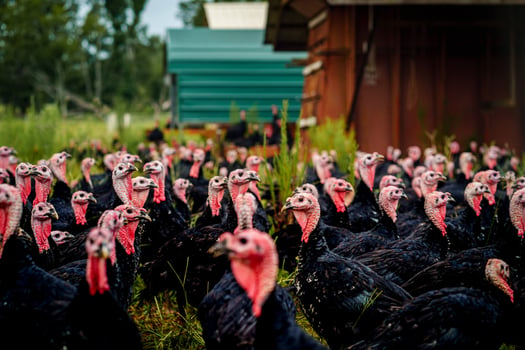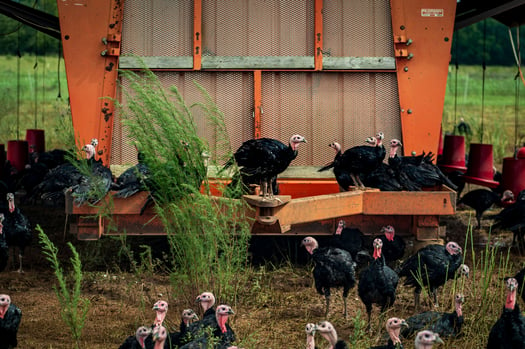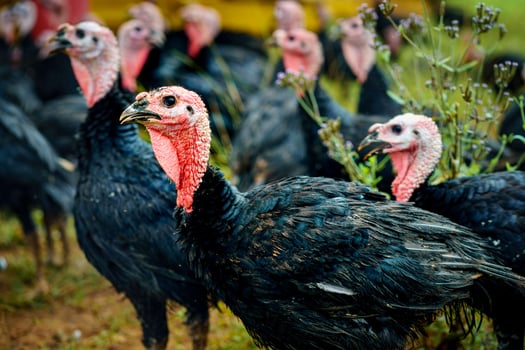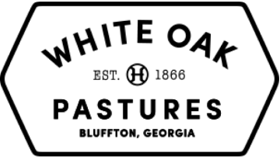.png?width=525&name=White%20Oak%20Pastures%20turkeys%20in%20pasture%20(1).png)
What's the difference between a pasture-raised turkey and a conventional feedlot turkey?
We provide this side-by-side comparison so that as a conscious consumer, you can make the decision which production model you choose to support.

Conventional turkeys eat a diet of processed feed, with no natural vegetation or bugs.
Our turkeys eat a diverse diet of fresh green things and foraged grub, supplemented with non-GMO feed and grit that we provide. Because turkeys are very effective grazers, able to convert some of their diet from pasture forage into body mass, they are moved every few days to fresh pasture.
Conventional turkeys are packed into confinement houses with little room to move, living under synthetic light and little to no access to outdoor spaces.
Our turkeys roam our pastures unconfined, with access to endless fresh air and forage, expressing their natural instincts. For the first few weeks of their lives, turkey poults live in protected, temperature-regulated brooder houses. At about 4 weeks old, our turkeys move to pasture and rest in roosting shelters at night (retro-fitted old cotton modules). Their grazing area is surrounded by electric fencing, to help reduce predator pressure, and livestock dogs guard the flock until they are big enough that eagles won’t bother them.

Conventional turkeys are given limited access to exercise and antibiotics to promote unnaturally fast fattening.
Our turkeys are never treated with antibiotics or steroids, and they gain weight at a natural rate without supplements. Our turkeys are Certified Non-GMO, Certified Humane, and Certified EOV by the Savory Institute.
Conventional turkeys are typically of the Broad Breasted White turkeys, which have been bred for shorter breast bones and larger breasts. They have been selected to gain weight quickly, getting to processing weight in 16-20 weeks. Selection for this trait leaves them flightless, usually unable to reproduce without artificial insemination, and prone to health problems related to being overweight (heart problems and respiratory failure due to excess muscle).
Our holiday birds are a Nicholas Black, a descendant of the Spanish Black Turkey and a breed that thrives out in pasture. These turkeys have a healthy appetite for foraged insects and vegetation and are adapted to life outdoors. The birds are hearty athletes who will perch and roost in trees even up until 15 weeks. Spanish Black Turkeys are a slow-growing bird, usually taking 24-26 weeks to get to slaughter weight (between 14-22 pounds, varying between hens and gobblers).

Conventional turkeys are processed mechanically using methods that could create a traumatic end-of-life for the birds. They are first packed into large trucks to be transported long distances to centralized meatpacking plants. Most plants rely on mechanized slaughter methods, such as hanging on a mechanical chain, for maximum speed of slaughter.
Our turkeys are slaughtered and butchered by hand in our on-farm, zero-waste, USDA-inspected processing abattoir. Our birds do not need to travel long distances to our on-farm processing plant, and our employees move each bird by hand throughout the plant, running our abattoirs at what we call a humane rate of slaughter. These efforts prioritize the welfare of both our animals and our employees.
Conventional turkeys are seen by large meat companies as a commodity to be efficiently grown and sold for profit in a linear and extractive system. Removed from their natural system and crammed into turkey brooding operations, the dense manure and animal impact from these turkeys can instead cause environmental harm through nitrate leaching and ammonia vaporization.
Our turkeys serve a higher purpose as a part of our holistic grazing system, turning soil from a dead mineral medium into one that’s teeming with life. Our turkeys follow cattle on newly acquired land, and by simply engaging in their natural behaviors, the turkeys' animal impact helps turn land into productive pasture. Their strong feet disturb the pasture surface, aerating the soil and preparing the land for new grasses that are beginning to grow. Their foraging activity helps spread and incorporate manure, increasing soil organic matter and sequestering carbon. Our turkeys are part of a cyclical system of animal husbandry and land stewardship.
At White Oak Pastures, we are proud to raise our turkeys using methods that benefit animal welfare, rural revival, and land regeneration.
Still want to know more about what it takes to raise our holiday turkeys? Check out these videos from our In The Dirt series, where previous Poultry Production Manager Mark Harrison takes you behind the scenes to show how we take care of our holiday turkeys.



